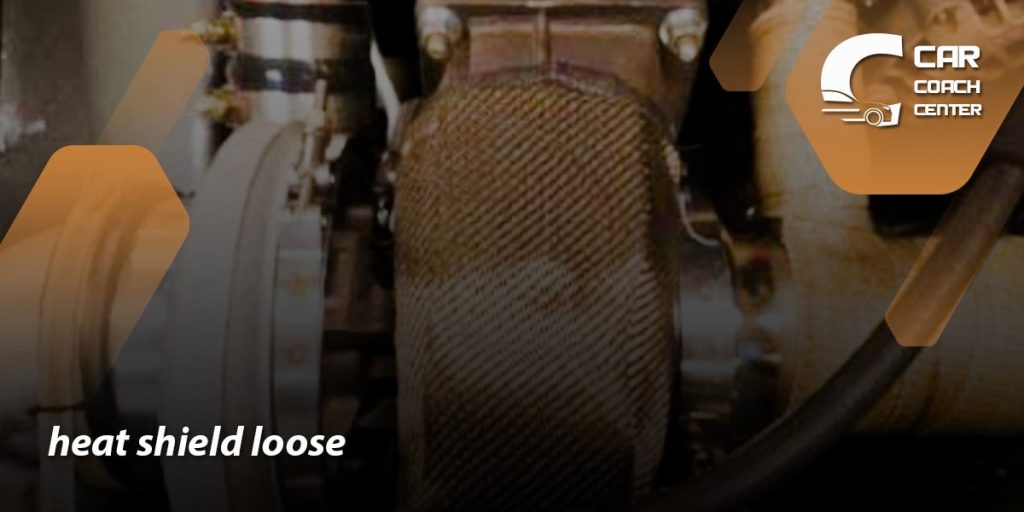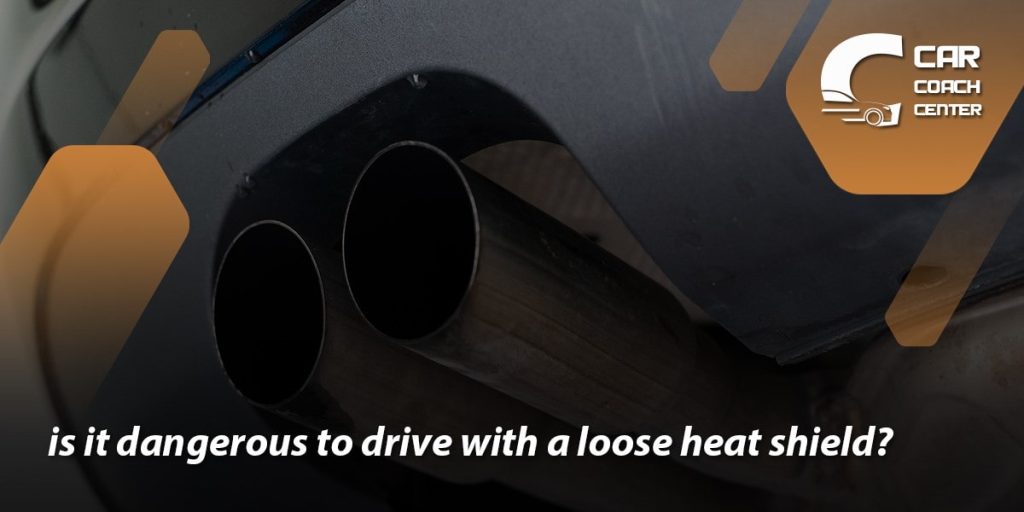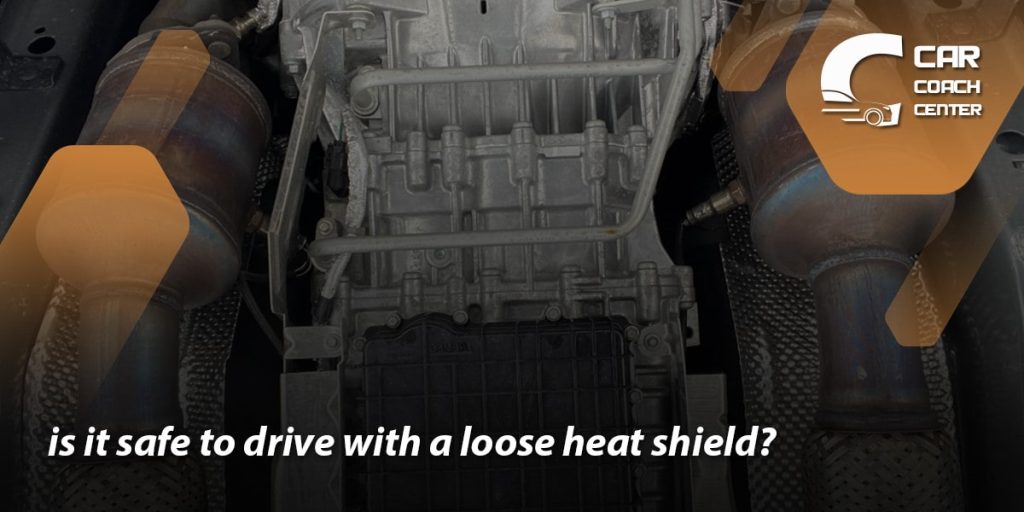Can You Drive With A Loose Heat Shield
As car enthusiasts, we revel in the joy of cruising down the open road, entranced by the purr of the engine and the wind whistling through the windows. However, amidst this automotive euphoria, it’s essential to remember that our beloved vehicles are complex machines comprising numerous intricate components that work harmoniously.
The heat shield is one such component, often overlooked but crucial for both performance and safety. Designed to protect various parts of the vehicle from the intense heat generated by the engine and exhaust system, a loose heat shield can pose a significant risk if addressed.

In this article, we delve into the intricacies of heat shields, exploring the potential dangers of driving with a loose heat shield and providing valuable insights on identifying, addressing, and preventing such issues. So buckle up and join us on this informative journey to ensure your driving experience remains safe and worry-free.
The Hidden Dangers: Unraveling the Impact of a Loose Heat Shield
Regarding vehicle maintenance, certain components often steal the spotlight, while others lurk in the shadows, awaiting their moment of recognition. Among these understated components is the heat shield, a seemingly inconspicuous part crucial in safeguarding your vehicle’s various systems.
The heat shield’s primary function is to shield sensitive components, such as the fuel lines, floorboards, and nearby wiring, from the intense heat generated by the engine and exhaust system. However, when a heat shield becomes loose or detached, it can give rise to various hidden dangers.
One of the most immediate risks associated with a loose heat shield is the potential for heat transfer. Excessive heat can penetrate nearby components without the shield acting as a barrier, leading to accelerated wear and tear. Over time, this heat exposure can cause damage to fuel lines, electrical wiring, and other vulnerable parts. The heat can even radiate through the vehicle’s floorboards, resulting in discomfort for passengers and an overall compromised driving experience.
Furthermore, a loose heat shield can increase the likelihood of fires. The heat generated by the engine and exhaust system is intense enough to ignite flammable materials if they come into direct contact. Near debris or fluids can easily contact the hot surfaces without a properly secured heat shield, creating a potentially hazardous situation. The consequences of a fire within the engine compartment can be catastrophic, causing extensive damage to the vehicle and putting the lives of the occupants at risk.
Additionally, a loose heat shield can contribute to excessive noise and vibrations. The shield is designed to dissipate heat and absorb and dampen vibrations produced by the engine and exhaust system. When the shield is loose or detached, these vibrations can reverberate through the vehicle, increasing noise levels. This can be particularly noticeable during acceleration or at high speeds, causing discomfort for the driver and passengers.
The Mechanics of a Heat Shield: Why It’s Vital for Your Vehicle
Underneath your vehicle’s hood lies a complex network of systems working together to propel you forward. Among these intricate components, the heat shield is a silent guardian, protecting your vehicle and ensuring its optimal performance. To truly understand the importance of a heat shield, it’s essential to delve into its mechanics and its critical role in your vehicle’s overall well-being.
The primary purpose of a heat shield is to safeguard sensitive parts of your vehicle from the intense heat generated by the engine and exhaust system. Comprised of a thin metal layer, often made of aluminum or stainless steel, the heat shield acts as a barrier, preventing excessive heat transfer to nearby components. Effectively dissipating and redirecting the heat away from critical areas helps maintain their functionality and extend their lifespan.
Fuel lines, for instance, are highly susceptible to heat damage. Fuel lines can degrade when exposed to excessive heat, resulting in leaks or even fuel vaporization. A properly installed heat shield provides a protective barrier, reducing the risk of fuel line damage and potential hazards associated with fuel leaks.
The heat shield also plays a pivotal role in safeguarding the vehicle’s electrical system. Wires and cables near the engine and exhaust system are vulnerable to the heat’s harmful effects. Extreme temperatures can cause insulation to melt or wires to become brittle, leading to electrical malfunctions, short circuits, or even fires. The heat shield acts as a barrier, deflecting the heat away from the sensitive wiring, thus preserving the integrity and functionality of the electrical system.
Moreover, the heat shield contributes to the overall comfort of the vehicle’s occupants. By reducing the transmission of heat, it helps maintain a cooler cabin temperature, preventing discomfort during hot weather conditions. Additionally, the shield acts as a noise and vibration dampener, minimizing the intrusive sounds and vibrations produced by the engine and exhaust system. This ensures a quieter and more enjoyable driving experience for the driver and passengers.

Loose Heat Shields: Signs, Symptoms, and Red Flags You Shouldn’t Ignore
While the heat shield is essential to your vehicle, it is not immune to potential issues. Over time, heat shields can become loose or detached, compromising their ability to protect and function effectively. Recognizing the signs and symptoms of a loose heat shield is crucial to address the problem promptly. Here are some common indicators that should raise red flags and prompt you to take action.
Rattling or Clanking Noises
One of the most noticeable signs of a loose heat shield is a rattling or clanking noise from the engine area. As the heat shield becomes loose, it may vibrate or contact other nearby components, resulting in audible noise. This noise is often more prominent during acceleration or when the engine is under load.
Excessive Heat in the Cabin
A loose heat shield may disrupt the proper dissipation of heat, leading to increased temperatures in the cabin. If you notice that your vehicle’s interior feels excessively hot, especially near the floorboards, it could indicate that the heat shield is not effectively redirecting the heat away from the passenger compartment.
Burning Smell
A loose heat shield can increase the likelihood of heat transfer to surrounding materials. This can result in a burning smell, indicating that nearby components or debris are coming into contact with hot surfaces. If you detect a burning odor while driving, it’s important to investigate the source promptly.
Reduced Performance and Fuel Efficiency
As a loose heat shield disrupts the proper airflow within the engine compartment, it can lead to overheating issues. Engine overheating can reduce performance, decrease power output, and even damage. Additionally, it can negatively impact fuel efficiency, causing a decrease in miles per gallon.
Visible Damage or Displacement
Regular visual inspections can reveal obvious signs of a loose heat shield. Look for visible damage on the heat shield, such as dents, cracks, or corrosion. Additionally, if the shield appears to be hanging or out of place, it may be an indication that it is no longer securely attached.
Warning Lights
A loose heat shield can sometimes trigger warning lights on the vehicle’s dashboard. Engine temperature warning lights or check engine lights may illuminate due to the disruption in the proper functioning of the engine or exhaust system. If you notice any warning lights, it’s important to have your vehicle inspected by a professional.
Risk vs. Safety: Weighing the Consequences of Driving with a Loose Heat Shield
When faced with a loose heat shield in your vehicle, you might wonder whether it’s safe to continue driving or if immediate action is required. While ignoring the issue or delaying repairs may be tempting, it’s crucial to understand the potential consequences and evaluate the risks involved. Let’s examine the factors and weigh the potential outcomes of driving with a loose heat shield.
Increased Risk of Fires
One of the most significant dangers of driving with a loose heat shield is the heightened risk of fires. Without the heat shield’s protective barrier, nearby debris or flammable materials can come into direct contact with the hot surfaces of the engine or exhaust system. This contact can lead to ignition and potentially result in a vehicle fire, putting your safety and the safety of others at risk.

Damage to Surrounding Components
A loose heat shield allows excessive heat to transfer to nearby components, such as fuel lines, electrical wiring, or even the vehicle’s floorboards. The heat can cause accelerated wear and tear, leading to potential failures and costly repairs. Ignoring the issue can result in the deterioration of essential systems, compromising your vehicle’s overall performance and reliability.
Compromised Safety of Passengers
Driving with a loose heat shield can also affect the comfort and well-being of passengers. Without the shield’s ability to dissipate heat properly, the cabin temperature may become excessively hot, making the driving experience uncomfortable and potentially causing distress or fatigue. Moreover, a loose shield’s increased noise and vibrations can contribute to a less pleasant and distracting ride.
Potential for Engine Damage
The heat generated by the engine and exhaust system must be managed properly to ensure optimal performance. A loose heat shield disrupts the airflow dynamics, potentially leading to engine overheating. Excessive heat can cause engine components to warp, degrade, or malfunction, resulting in reduced power output, increased fuel consumption, and even engine failure. Driving with a compromised heat shield increases the risk of costly repairs and can shorten the lifespan of your vehicle’s engine.
Legal and Regulatory Compliance
Considering the legal and regulatory implications of driving with a loose heat shield is important. Vehicles must adhere to safety standards in many jurisdictions, and driving with a malfunctioning or compromised component may violate those requirements. It can result in penalties, fines, or even restrictions on your ability to operate the vehicle legally.
DIY Fixes or Professional Help: How to Deal with a Loose Heat Shield
Encountering a loose heat shield in your vehicle can be a cause for concern, but the good news is that options are available to address the issue effectively. Consider attempting a DIY fix or seeking professional help when dealing with a loose heat shield. Let’s explore both approaches to help you make an informed decision.
DIY Fixes
Visual Inspection
Start by visually inspecting the heat shield for any visible damage, loose fasteners, or signs of detachment. Ensure that the shield is securely attached to its designated mounting points.
Tightening Fasteners
If the heat shield is loose but still intact, you can tighten the fasteners yourself. Using the appropriate tools, carefully secure loose bolts, nuts, or clips holding the heat shield in place.
Heat-Resistant Adhesive
In some cases, a loose heat shield may require additional support to remain securely attached. Consider using heat-resistant adhesive, designed specifically for automotive applications, to reinforce the bond between the heat shield and its mounting points. Follow the adhesive manufacturer’s instructions for proper application.
Professional Help
Expert Diagnosis
If you are unsure about the severity of the issue or need more tools and experience, it’s advisable to seek professional help. A certified mechanic or automotive technician can perform a comprehensive inspection, accurately diagnose the problem, and determine the best action.
Professional Repair or Replacement
Depending on the condition of the heat shield, a professional may recommend repair or replacement. They have the expertise and access to the necessary tools and parts to do the job effectively. Professional repair ensures the heat shield is properly installed, aligned, and securely fastened to its designated mounting points.

Overall Safety Check
Opting for professional assistance allows for a comprehensive vehicle safety check. The mechanic can inspect other related components, such as fuel lines, electrical wiring, and exhaust systems, to ensure no underlying issues or potential hazards.
Preventative Measures: Maintenance Tips to Avoid Heat Shield Issues
Prevention is key when it comes to ensuring the longevity and optimal performance of your vehicle’s heat shield. You can minimize the risk of heat shield issues by implementing regular maintenance practices and taking proactive measures. Here are some valuable maintenance tips to help you avoid potential problems.
Routine Visual Inspections
Perform regular visual inspections of the heat shield. Look for any signs of damage, such as dents, cracks, or corrosion. Ensure the shield is securely fastened and properly aligned with its mounting points. Early detection of any issues allows for timely repairs or replacements.
Check Fasteners
Pay attention to the fasteners that secure the heat shield. Over time, vibrations and temperature fluctuations can cause them to loosen. Periodically check and tighten the bolts, nuts, or clips holding the heat shield. However, exercise caution not to overtighten, as it may cause damage or distortion to the shield.
Avoid Excessive Moisture and Corrosive Substances
Exposure to moisture and corrosive substances can accelerate the deterioration of the heat shield. Whenever possible, avoid driving through deep water, where the heat shield may come into contact with excessive moisture or corrosive agents. If the shield does get wet, allow it to dry completely to prevent corrosion.
Mindful Driving Habits
Be mindful of your driving habits to reduce unnecessary strain on the heat shield. Avoid excessive acceleration, abrupt braking, and driving over rough terrain whenever possible. These actions can subject the heat shield to increased vibrations and potential impacts, leading to loosening or damage.
Regular Maintenance Schedule
Follow the manufacturer’s recommended maintenance schedule for your vehicle. Regularly servicing your vehicle ensures that all components, including the heat shield, are inspected and maintained optimally. Your mechanic can check the condition of the shield during routine maintenance and address any potential issues.
Professional Inspections
Consider scheduling periodic professional inspections, especially if you notice any signs of heat shield issues or suspect other underlying problems. A certified mechanic or automotive technician can perform a thorough examination, ensuring that the heat shield and related components are functioning properly.
conclusion
In conclusion, understanding the significance of a heat shield and being aware of the potential risks associated with a loose heat shield is crucial for every vehicle owner. The heat shield is a vital protective barrier, safeguarding sensitive components and ensuring optimal performance.
By promptly addressing any signs of a loose heat shield and making informed decisions regarding DIY fixes or seeking professional help, you prioritize safety and prolong the lifespan of your vehicle. Additionally, implementing preventative maintenance measures, such as routine inspections and mindful driving habits, can reduce the likelihood of heat shield issues.
Remember, proper maintenance and timely repairs are essential to preserve the integrity of your vehicle’s heat shield and ensure a safe and enjoyable driving experience. For more automotive tips, maintenance advice, and informative articles, visit carcouchcenter.com, where you can find a wealth of resources to enhance your automotive knowledge and keep your vehicle running smoothly.
Can I temporarily secure a loose heat shield myself?
Yes, you can attempt to tighten the fasteners or reinforce the shield with heat-resistant adhesive as a temporary fix.
Is driving with a loose heat shield dangerous?
Driving with a loose heat shield can pose risks, including potential fires, damage to surrounding components, compromised safety, and engine issues.
How often should I inspect my heat shield?
Inspecting the heat shield during routine maintenance visually or whenever you notice signs of damage is recommended.


